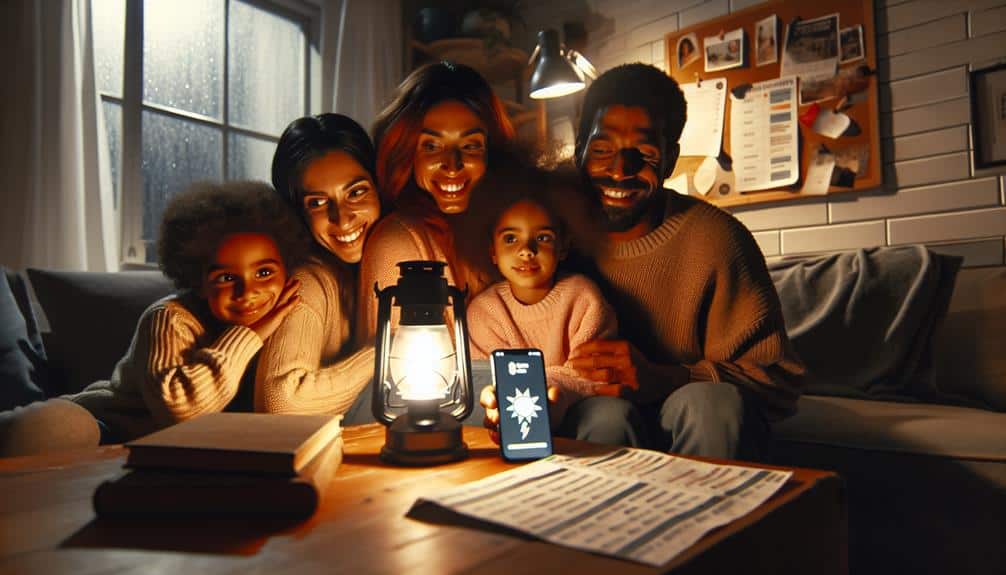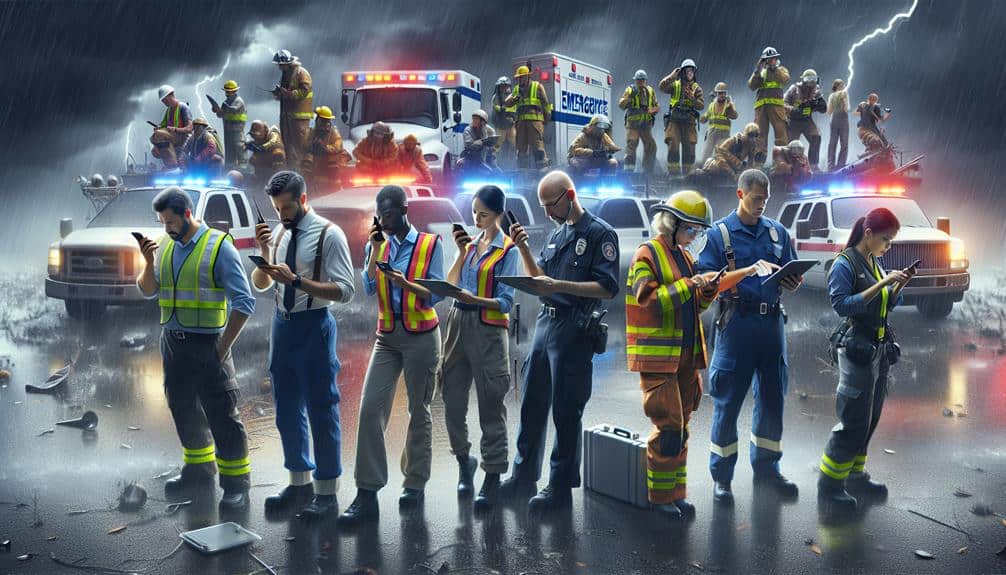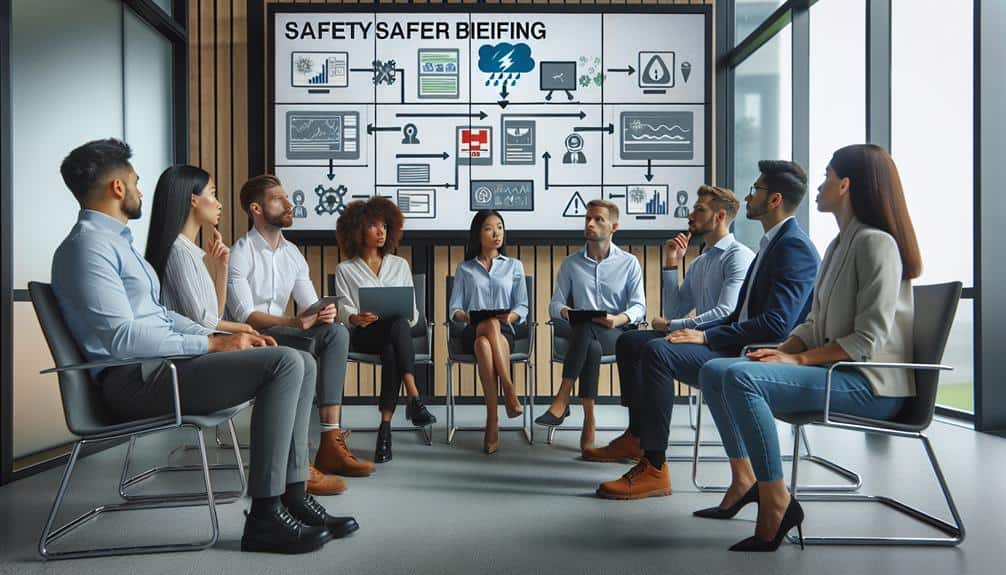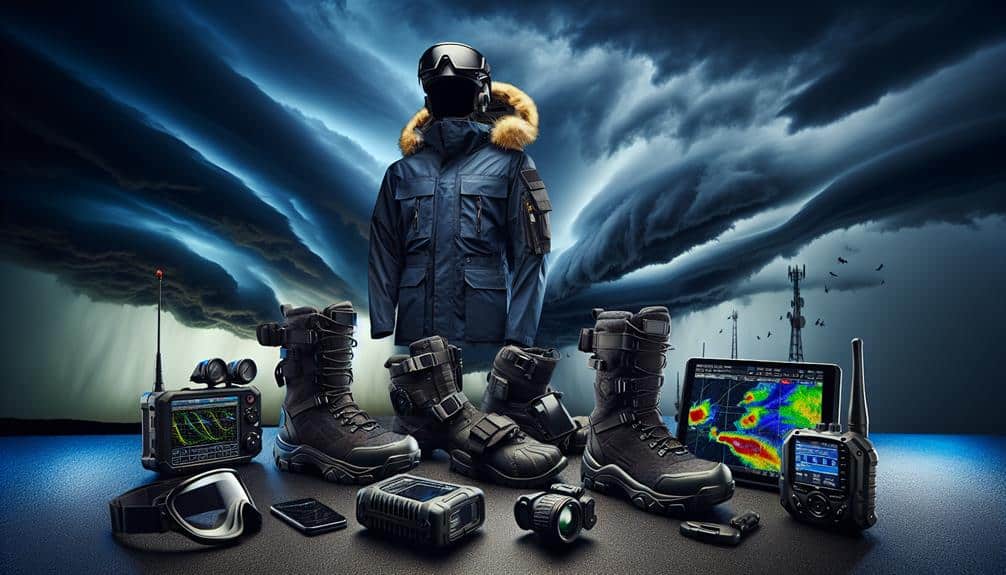Staying informed and safe during a storm requires clear communication practices. We start by establishing clear roles and using reliable, sturdy communication equipment with backup power. Regularly check-in and use live weather updates from trusted sources. Sharing live locations helps keep everyone accounted for. Coordinating with authorities guarantees a unified response. We need backup plans for equipment failures and educate our team with safety information and drills. These steps help us prepare and respond effectively. To investigate all the methods in detail, we can delve deeper into these practices and ensure thorough storm readiness.
Key Points
- Assign clear team roles and responsibilities to ensure swift and decisive action during storms.
- Use durable, waterproof communication devices to maintain reliability in harsh conditions.
- Regularly test communication equipment to guarantee operational reliability during emergencies.
- Set up emergency signals for quick recognition and effective communication in urgent situations.
Establish Clear Roles
To make certain everyone knows their responsibilities during a storm, we need to establish clear roles within our team. By doing this, we guarantee smooth operations and swift responses when it matters most. Clear roles help in establishing trust among team members, as everyone knows who to turn to for specific tasks. This clarity eliminates confusion and fosters a sense of security.
Effective storm response is rooted in clear communication. We must outline each role thoroughly, so nobody is left guessing. For instance, designate someone to monitor weather updates, another to manage supplies, and others to handle communication with external agencies. By doing this, we streamline our efforts and maximize efficiency.
Assigning roles isn't just about delegation; it's about empowering each team member. When we trust each other to perform our designated duties, we're not only more effective but also more resilient. This trust builds a solid foundation for quick, decisive action when storms hit.
Use Reliable Equipment
Let's guarantee our communication equipment is reliable by selecting durable devices that can withstand harsh conditions.
We should also have backup power sources ready to keep us connected during outages.
Regularly testing our equipment will help us validate its reliability when we need it most.
Choose Durable Devices
When preparing for a storm, we need to prioritize using sturdy devices that can withstand harsh conditions. Our safety and freedom depend on dependable communication, so let's focus on device maintenance and selecting waterproof options. Keeping our equipment in top shape guarantees it'll perform when we need it most. Regular checks and timely repairs are non-negotiable.
A waterproof device isn't just a luxury; it's essential. It guarantees our communication tools remain functional despite adverse weather.
For emergency communication, we must consider satellite phones. Unlike traditional cell phones, satellite phones don't depend on terrestrial networks, which can easily become overwhelmed or damaged during a storm. Satellite phones offer a direct line to help, no matter how severe the conditions. They provide us the freedom to reach out for assistance when other lines of communication fail.
Backup Power Sources
In the face of unpredictable storms, we must make certain we've dependable backup power sources to keep our communication devices operational. Without power, our ability to stay informed and connected can disappear when we need it most. That's why integrating solar panels and battery banks into our emergency plans is vital.
Solar panels offer a sustainable and renewable way to generate electricity, even when the grid goes down. They harness the sun's power, providing a continuous energy source as long as daylight is available. Pairing them with battery banks guarantees that we can store this energy for use during nighttime or overcast conditions. Reliable battery banks are essential; they act as the backbone of our power strategy, ensuring our devices remain charged and functional throughout the storm.
We don't want to rely solely on one type of backup power. Diversifying our power sources with both solar panels and battery banks gives us the flexibility to adapt to various storm conditions. This approach not only safeguards our communication devices but also grants us the freedom to stay connected and informed, no matter the circumstances.
Test Regularly for Reliability
Regular testing of our backup power systems ensures they'll perform dependably when we need them most. We must prioritize equipment maintenance to make sure that every component functions as expected during a storm. By routinely inspecting and servicing our generators, batteries, and other vital infrastructure, we minimize the risk of failure when the stakes are high.
Our communication protocols play a crucial role in storm safety. Reliable equipment is necessary for maintaining clear lines of communication. We should regularly test radios, satellite phones, and other communication devices to confirm they're operational. This isn't just about checking if they turn on; it's about verifying they transmit and receive signals clearly and without interruption.
Additionally, it's important to have a schedule for these tests. Regular drills and simulations can help identify weak points in our systems and protocols, allowing us to address issues proactively. By adopting these practices, we empower ourselves with the freedom to act swiftly and decisively during emergencies.
Implement Check-In Systems

To guarantee everyone's safety during a storm, we need to establish efficient check-in systems for regular updates and accountability. Our emergency plans should include clear communication protocols, making sure every team member knows when and how to check in. By doing this, we create a streamlined process where information flows seamlessly, keeping everyone informed and prepared.
Our check-in system must emphasize team accountability. Each member's role in safety checks should be well-defined, leaving no room for confusion. When a storm hits, timely updates are essential, and knowing that everyone has checked in keeps us all reassured. We can use various methods—whether it's a group chat, a dedicated app, or even a simple phone call—to confirm everyone's safety and whereabouts.
Let's not forget, the essence of freedom lies in being prepared and responsive. An efficient check-in system empowers us to act swiftly and confidently, knowing that our communication network is robust and reliable. By integrating these practices into our storm safety protocols, we make sure that we can weather any storm with resilience and assurance, knowing we've got each other's backs.
Monitor Weather Updates
We must stay informed by using real-time alert systems, tuning into local news channels, and regularly checking weather apps. These tools provide critical updates that can help us make timely decisions.
Real-time Alert Systems
Monitoring weather updates in real-time is crucial for ensuring timely and effective storm safety measures. By staying informed, it enables us to swiftly implement safety protocols that protect our families and communities. Real-time alert systems offer us the flexibility to make informed decisions and take control of our safety.
We can depend on these systems to provide immediate updates on storm paths, wind speeds, and potential hazards. This information allows us to coordinate emergency response efforts efficiently. When we're fully aware of what to expect, we can prepare our homes, secure necessary supplies, and evacuate if needed, all without unnecessary delays.
Real-time alerts also empower us to communicate effectively with loved ones and neighbors. By sharing accurate, up-to-the-minute information, we help everyone stay on the same page and work together to stay safe. It's about creating a network of vigilance and support, ensuring that no one is left unprepared.
Let's not overlook the power of these systems. They're tools that provide autonomy and security. By utilizing real-time alerts, we can navigate storm threats with confidence and resilience, safeguarding our freedom to live without fear.
Local News Channels
Local news channels play a vital role in keeping us informed about impending storm conditions and necessary safety measures. They offer real-time updates that are essential for our emergency response planning. By tuning in, we can stay ahead of rapidly changing weather patterns and make timely decisions to protect our families and properties.
These channels excel in community outreach, providing information tailored to our specific areas. Unlike national channels, local news stations focus on hyper-localized weather reports, making certain we get the most relevant updates. They often collaborate with local authorities and emergency services to relay critical information, like evacuation routes and shelter locations.
We should make it a habit to monitor these channels, especially during storm seasons. Their dedicated meteorologists and reporters work around the clock to gather the most accurate data, often broadcasting live from affected areas. This on-the-ground reporting gives us a clear picture of what's happening and what actions we need to take.
In times of crisis, local news channels are our lifeline, delivering the information we need to navigate storms safely. Their commitment to community outreach and emergency response helps secure we're not caught off guard when severe weather strikes.
Weather Apps Usage
Utilizing weather apps allows us to receive timely and precise updates directly on our mobile devices, making sure we're always informed about approaching storms. These apps have evolved to offer a range of weather app features that enhance our user experience significantly. From real-time radar maps to detailed forecasts, they provide us with the accuracy we need to make informed decisions about our safety.
One of the most beneficial aspects of weather apps is the weather app notifications. These alerts can be customized to our preferences, allowing us to receive updates on specific weather conditions that matter most to us. Whether it's a tornado warning or a severe thunderstorm alert, we can set the app to notify us immediately, giving us the freedom to plan and act swiftly.
Customization options in these apps also mean we can tailor the data to suit our needs, from choosing the type of map overlays to setting the frequency of updates. This flexibility guarantees that we get the most relevant information in the most convenient way possible.

Sharing real-time locations can significantly improve our safety and coordination during a storm. By knowing each other's exact positions, we can make informed decisions and act swiftly if someone is in danger. Implementing safety protocols becomes more effective when we share our locations, as it allows us to track movements and guarantee everyone is following the agreed-upon plans.
One of the first steps in this process is to set up emergency contacts. We should make sure that our closest friends, family, and local authorities have access to our location data. This capability can be a lifesaver, enabling rapid response if someone gets trapped or needs immediate help. Many smartphone apps offer real-time location sharing, making it easy for us to stay connected and aware.
Real-time location sharing also helps us avoid hazardous zones. By monitoring each other's locations, we can steer clear of areas where the storm's impact is most severe. This proactive measure guarantees we aren't caught off-guard and can find safer routes or shelters.
In essence, sharing real-time locations empowers us to take control of our safety, enhancing both individual and group security during a storm.
Set Up Emergency Signals
To guarantee quick and effective communication during a storm, we must establish clear emergency signals that everyone understands. Setting up these signals is essential for prompt safety responses and securing that our communication strategies are robust.
Here's how we can accomplish this:
- Visual Signals: Use easily recognizable visual signals, such as flashing lights or colored flags, to convey different levels of urgency. This ensures quick signal recognition even from a distance.
- Auditory Signals: Implement distinct sounds like whistles, horns, or bells. Each sound should correspond to a specific emergency scenario, allowing us to react without confusion.
- Pre-Defined Codes: Establish a set of pre-defined verbal codes that can be communicated over radios or cell phones. These codes should be simple and unambiguous, securing everyone knows exactly what action to take.
- Practice Drills: Regularly conduct safety drills to reinforce our emergency signals. Practicing these drills helps everyone become familiar with the signals and improves our overall safety response.
Coordinate With Authorities

During a storm, it's important that we coordinate closely with local authorities to guarantee timely and accurate information flow. By doing so, we enhance our emergency response capabilities and secure that our community remains well-informed and prepared.
We must establish direct lines of communication with emergency services, making certain that any updates or instructions are relayed promptly. This includes monitoring official channels like local government websites, social media, and emergency alerts. By staying connected with authorities, we can act swiftly and decisively, minimizing risks and optimizing our safety.
Community outreach plays a vital role in this coordination. We need to actively share the information we receive from authorities with our neighbors, especially those who mightn't have immediate access to these updates. This collective effort secures that everyone in our community is on the same page, reducing confusion and enhancing overall safety.
It's also important that we participate in community meetings and emergency response drills organized by local authorities. These activities not only provide valuable information but also foster a sense of unity and preparedness among us. By collaborating with authorities and each other, we can confidently navigate any storm that comes our way.
Develop Backup Plans
Creating strong backup plans is vital to guarantee our safety and resilience during a storm. We must anticipate potential disruptions and prepare accordingly. By implementing contingency plans and communication backups, we safeguard that our emergency response remains effective even under adverse conditions.
Here are four key steps we should follow:
- Identify Key Risks: Determine the specific threats posed by the storm, such as power outages, flooding, or communication breakdowns. This knowledge will help us tailor our contingency plans to address these risks effectively.
- Establish Communication Backups: Prepare alternate communication methods in case primary channels fail. Options might include satellite phones, two-way radios, or even social media platforms that can function with minimal internet connectivity.
- Develop Alternate Strategies: Create specific action plans for different scenarios. For example, if evacuation becomes necessary, identify multiple safe routes and meeting points to avoid congestion and confusion.
- Regularly Update Plans: Ensure that our backup plans are current and reflect any changes in our environment or resources. Regular reviews and updates are essential to maintaining their effectiveness.
Educate Team Members

Let's make sure our team is well-prepared by conducting regular training sessions and distributing safety information materials.
We'll make certain everyone knows the protocols and can act swiftly in an emergency.
Keeping our team informed and trained is vital for storm safety.
Conduct Regular Training Sessions
Conducting regular training sessions guarantees our team is well-prepared and confident in their storm safety responsibilities. These sessions should be more than just routine; they need to be engaging and thorough. By incorporating interactive simulations and team building exercises, we not only enhance our team's skills but also foster a sense of unity and trust. These elements are essential when quick, decisive action is required during a storm.
We should focus on scenario-based training to prepare for any situation that might arise. This method helps us practice real-life responses and fine-tune our communication strategies. When everyone knows their role and how to communicate effectively, we minimize confusion and maximize efficiency.
To make sure our training sessions are effective, we should include the following:
- Interactive Simulations: These allow team members to experience potential storm scenarios in a controlled environment.
- Team Building Exercises: Strengthen trust and cooperation among team members.
- Scenario-Based Training: Prepare for a variety of potential situations, enhancing readiness.
- Communication Strategies: Teach clear and effective ways to convey critical information.
Distribute Safety Information Materials
Distributing detailed safety information materials guarantees that every team member is well-informed and prepared for storm-related emergencies. It's essential that we take proactive steps to educate our team through in-depth materials, leaving no room for confusion when a storm hits.
Effective information dissemination can be achieved through multiple channels. Leveraging neighborhood networks allows us to reach everyone quickly and efficiently. We should also utilize community outreach initiatives to make sure that the broader community is equally informed. Safety workshops play a pivotal role in this process, providing hands-on experience and fostering a deeper understanding of storm safety protocols.
We must curate materials that are clear and actionable. This includes checklists, emergency contact numbers, evacuation routes, and safety precautions. Making these materials accessible both digitally and in print guarantees that everyone can have them on hand, regardless of their preferred medium.
Perform Regular Drills
Regular exercises are necessary to guarantee everyone knows exactly what to do when a storm hits. They foster drill effectiveness and reinforce vital safety measures. By practicing regularly, we build muscle memory that kicks in automatically during a real event.
Here's how we can make sure our exercises are both effective and thorough:
- Set Clear Objectives: Define what we want to achieve with each drill. Are we testing our evacuation routes or communication techniques? Clear goals lead to targeted practice.
- Rotate Scenarios: Storms can vary. Alternate between different types of storm scenarios to ensure comprehensive preparedness. This keeps everyone on their toes and ready for anything.
- Evaluate and Improve: After each drill, debrief as a team. Discuss what worked and what didn't. This feedback loop is important for continuous improvement and team coordination.
- Incorporate Realism: Make the drills as realistic as possible. Use alarms, simulate power outages, and include obstacles. Realistic drills enhance our readiness and response efficiency.
Frequently Asked Questions
What Should Be Included in a Personal Emergency Kit?
In our personal emergency kit, we should include essential emergency supplies like water, food, flashlight, batteries, first aid kit, and medications. Don't forget a communication plan with contact numbers and a portable charger for phones.
How Do You Communicate With Family Members During a Storm?
It's tough to keep everyone calm, but sticking to our emergency plans helps. Regular check-ins guarantee family communication stays strong. We send updates through group texts, keeping everyone informed and connected during the storm.
What Are the Best Apps for Weather Alerts?
We've found that the best apps for weather alerts are Weather Underground and NOAA Weather Radar. They provide real-time weather monitoring, essential for emergency preparedness. Their accuracy and reliability guarantee we're always ready for any storm.
How Can You Assist Neighbors With Special Needs During a Storm?
Did you know 15% of people have special needs? Let's engage in community outreach and assistance. We can offer neighborly support by preparing emergency plans, ensuring supplies, and checking in regularly to help those who need it most.
What Should You Do if Phone Lines Are Down?
If phone lines are down, we should use our emergency communication methods like walkie-talkies or satellite phones. Let's implement our backup plans, such as meeting points or pre-arranged signals, to stay connected and guarantee safety.


